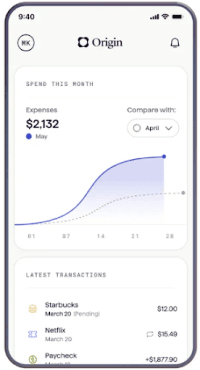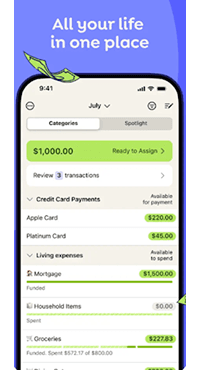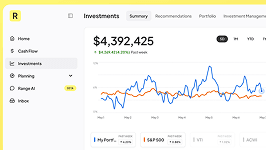Top Financial Aggregators to Track All Your Accounts for 2025
Want to see all your accounts in one place? These handy apps might just be what you need.


A financial account aggregator, or an “open” banking app, connects financial account information from multiple institutions, banks and credit unions.
In other words, it’s a tool that pulls in your account info from different places (bank, credit card, loans, investments) and shows it all in one dashboard or app.
If you’re someone who has multiple financial accounts from several banks, then a financial account aggregator could make it easier to manage all your accounts.
Financial aggregator apps are often offered by financial technology (fintech) companies. Compare these top aggregator apps that could help organize your finances:

Origin is an all-in-one finance app where you can sync your bank and investment accounts to view them all in one place. And while most financial apps only use Plaid to link accounts, Origin uses three: Plaid, Finicity and MX. Origin offers aggregation, budgeting tools, credit score tracking, tax filing, estate planning, investment planning and much more. One of the better perks of Origin is its Cash Management Account that earns up to 4.5% APY.
There is a seven-day free trial to test it out, but after that, Origin costs $12.99 per month or $99 per year.

You Need a Budget (YNAB) is a renowned budgeting app, with great customer reviews and an intuitive interface. It uses the zero-based budgeting method, so every dollar has a purpose. While it’s mostly known as a budget app, it’s also a financial aggregator, since you can sync your various accounts, including checking, savings, credit cards and investment accounts. YNAB can use direct imports, or you can link accounts directly with Plaid, MX and TrueLayer. View your linked account transactions, create custom bill categories, sync with various smart devices and create and track your budget.
YNAB offers a free 34-day trial, then costs $14.99 per month ($179.88 for one year), or you can pay annually for $109.

Monarch Money allows you to add your spouse or anyone in your household to one subscription, making it perfect for couples and families. You can connect accounts using Plaid, Finicity and MX to view everything on one dashboard to track accounts, subscriptions, expenses and credit cards. Couples can set up shared savings goals and work toward them together on the dashboard. For budgeting, you can choose between two options: Flex Budgeting, which focuses on buckets with flexible spending, or Category Budgeting, which organizes your spending into categories.
Monarch Money is priced similarly to other budgeting apps, costing $14.99 per month ($179.88 annually) or $99 per year with an annual subscription.

Empower offers traditional budgeting and investing tools with no monthly fees or ads. Its free Personal Dashboard syncs various accounts like bank accounts, loans and investments through Plaid. Track your income, expenses and transactions, and organize with labels, set savings goals and view a pie chart for budgeting. As a financial aggregator app, it provides a great overview of your finances, though it’s less focused on detailed budget planning. Empower used to be mostly desktop-based for its wealth services, but now focuses on mobile-only management.
The base Empower app is free to use, and to access premium features, pricing is $7.99 per month. Empower also has the Empower Personal Cash account, offering up to 3.75% APY with no monthly fees.

Designed for high-earning professionals with a lot of assets to manage, Range is an all-in-one wealth management platform that can aggregate your financials. It gives you a full picture of your finances, such as investment management, tax strategy, cash flow tracking, estate planning, retirement forecasts, insurance reviews, real estate guidance and more. On the downside, they don’t have a mobile app just yet, so you’ll have to manage things on a desktop.
While it has powerful tools, it’s a yearly commitment and is admittedly a little pricey. It has three plans and a flat-free pricing model, ranging from $2,655/yr for Premium, $5,355/yr for Platinum and $8,955/yr for Titanium.

PocketSmith provides a flexible way to manage your finances, offering a desktop and app version. It stands out with its unique forecasting feature, which helps you plan for the future by projecting your income and expenses over days, months or up to 30 years in the future. Sync multiple accounts, including bank accounts, credit cards and investments, and create customizable categories for tracking spending and setting goals. PocketSmith uses bank feeds, which let you add accounts and import transactions, or you can import your bank files to the app. And if you’re switching from another budget app, like Mint, Quicken or YNAB, PocketSmith also has custom import tools.
PocketSmith costs $9.95 per month for the basic plan, with more advanced features available in the premium and super plans.
Financial aggregators securely pull data from different financial institutions and display it in one place. These apps connect to your chosen accounts with secure Application Programming Interfaces (APIs), which ensures that your login details are never stored by the app itself.
Once connected, the app consolidates your financial data, giving you a complete overview of your spending, savings, debts and investments across all accounts. With this aggregated data, you can track trends in your spending habits, like identifying recurring expenses or noticing areas where you can cut back.
Financial aggregator apps use a few key technologies to keep your accounts and information safe.
Financial aggregators can make it easy to manage multiple accounts by securely pulling all your data from different places and showing it in one spot. These apps connect to your bank accounts, credit cards, loans and investments using secure APIs, so your login info is never stored by the app. Plus, many financial aggregators let you set up budgets and savings goals by categorizing your spending.
Aggregator apps can be great for managing your bank accounts, but what if your bank account isn’t great? Compare our editorial picks for the best checking accounts and best savings accounts in the market.
Most aggregator apps support linking checking and savings accounts, credit cards, loans and investment accounts. Whether or not your specific bank account will sync can depend on the aggregator app itself, and many apps use Plaid, Finicity, TrueLayer or MX (sometimes more) to link accounts.
Typically, yes, these apps are safe. Financial aggregators use secure connections, like encryption and two-factor authentication, to protect your data. These apps also usually only have “read-only” access to your accounts, so they can pull in your transactions but can’t make any changes or transactions on your behalf.
Yes, you’ll typically need to provide your login details when setting up the connection. However, due to security measures, login info isn’t stored by the app itself.
See how to earn up to $1,500 when you open a new Capital One savings or checking account with qualifying deposits.
Chime is a fintech company and not a true bank, so it can’t integrate with Zelle. But you can use Chime’s Pay Anyone for P2P payments.
The $500 Axos Bank bonus is now expired, but you can still earn $50 per qualifying referral.
Earn a checking account bonus of $200 by getting the Upgrade Card and making 3 qualifying transactions.
Fifth Third Bank currently offers a $325 checking account bonus when you open a new account and set up qualifying direct deposits.
Earn $25 with Varo by referring a friend. See the fine print on how to earn this bonus here.
One of PNC’s best bonus offers is its $400 direct deposit bonus. But if you don’t meet the criteria, there are other ways to earn cash.
Chime offers a competitive $100 referral bonus and a $100 direct deposit bonus when you meet certain requirements. See details here.
SoFi offers several bonus offers, including a direct deposit bonus, welcome offers and referral bonuses.
Instant sign-up bonuses with no deposit are not typically offered. However, these bank account bonuses have easy requirements.